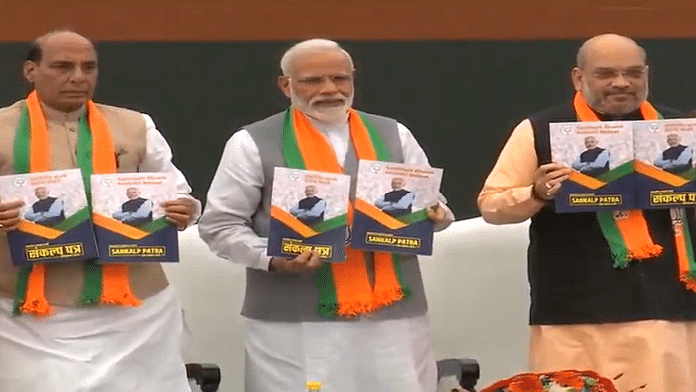New Delhi: The BJP’s ‘Sankalp Patra’ might be shorn of the bluster that the opposition Congress’ manifesto had, but the two documents sharply underline the difference in their approach in this election season: One is playing the politics of aspiration, and the other of entitlements.
The Congress had many things on offer for different segments — Rs 72,000 per annum to the poorest of the poor families, 24 lakh government jobs for the youth, “karz mukti” (loan waiver) for farmers, minimum support price for non-timber forest produce of tribals, 150 days of work under MNREGA, et al. Its ad campaign further buttresses this impression by projecting Rahul Gandhi as a benevolent benefactor.
The BJP has indulged in a bit of populism by expanding the scope of Rs 6,000 per annum incentive to farmers, and promising them pensions. It has also made an outreach to the middle class by promising to revise tax slabs and tax benefits to give more cash in hand.
Also read: Lower tax, pension for shopkeepers, pucca houses: BJP manifesto packed with populism
Facilitator for aspirational classes
The ‘Sankalp Patra’ has largely projected the BJP as a facilitator for aspirational classes. It has promised to invest heavily in infrastructure and the farm sector, create a Rs 20,000 crore ‘Seed Start-Up Fund’, set up a medical college in every district (through private or public initiatives), and provide pucca houses to every family and piped water to every household, among others.
These, as well as the promise to make India the third largest economy in the world, and improving the ‘Ease of Doing Business’ ranking, are all part of the ‘aspiration package’ presented by the ruling party. The BJP has promised to create opportunities for jobs and “self-employment”, but refrained from putting a number — probably wiser considering the flak it has received for promising 2 crore jobs a year in 2014.
These promises feed well into the BJP’s larger nationalism narrative, in which New India has zero tolerance for terrorism and can go across the border to crush terrorism “at its root”.
Hardline promises
Of course, the manifesto does address the concerns of the hardliners among BJP supporters by reiterating the party’s position on the implementation of the Uniform Civil Code, abrogation of Article 370, and expediting the construction of the Ram temple in Ayodhya (by exploring all possibilities within the framework of the Constitution) and by also adding the agenda of scrapping Article 35A.
BJP leaders in their speeches have been seeking to play up hyper-nationalism and create polarisation along communal lines. These issues help the party to consolidate its core vote bank, but have a limited impact on the aspirational classes who voted for Modi in 2014 for a different reason. The BJP’s ‘Sankalp Patra’ may serve as an olive branch to them.
Also read: Full text of BJP’s 2019 Lok Sabha election manifesto







The Manifesto has been released one day before campaigning halts for the first phase. Lots of empty plastic chairs in campaign rallies.